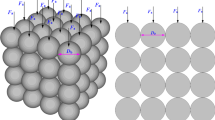Abstract
When applying the three-dimensional discontinuous deformation analysis (3D-DDA) method to simulate the dynamic response of rock mass in an earthquake, appropriate artificial boundaries and input methods should be considered. In this study, the 3D-DDA method was modified by introducing the viscoelastic artificial boundary and the seismic motion input method based on the wave field decomposition method and with the consideration of the lateral free-field wave. Subsequently, the correctness of the boundary and the input method was verified through numerical examples. The results of the numerical examples were almost consistent with the theoretical solution. The introduced viscoelastic artificial boundary and seismic motion input method improved the applicability of the 3D-DDA method and can be further applied to simulate actual engineering cases.
Highlights
-
Viscoelastic artificial boundary is applied and validated in 3D-DDA.
-
The differences between viscoelastic boundary and existing boundaries are compared.
-
Modified 3D-DDA can consider wave field decomposition and lateral free-field wave for seismic motion input.
-
Feasibility of modified 3D-DDA to study the dynamic response of rock mass in an earthquake is studied.

























Similar content being viewed by others

Data availability
The raw data supporting the conclusions of this article will be made available by the authors, without undue reservation.
References
Bao HR, Hatzor YH, Huang X (2012) A new viscous boundary condition in the two-dimensional discontinuous deformation analysis method for wave propagation problems. Rock Mech Rock Eng 45(5):919–928. https://doi.org/10.1007/s00603-012-0245-y
Cai JG, Zhao J (2000) Effects of multiple parallel fractures on apparent attenuation of stress waves in rock masses. Int J Rock Mech Min Sci 37(4):661–682. https://doi.org/10.1016/S1365-1609(00)00013-7
Deeks AJ, Randolph MF (1994) Axisymmetric time-domain transmitting boundaries. J Eng Mech 120(1):25–42. https://doi.org/10.1061/(ASCE)0733-9399(1994)120:1(25)
Fu XD, Sheng Q, Zhang YH (2012) Research on DDA method for response of slopes under excavation and dynamic load. Chin J Rock Mech Eng 31(S1):2612–2618. https://doi.org/10.3969/j.issn.1000-6915.2012.z1.003
Fu XD, Sheng Q, Zhang YH, Dai F (2015) Boundary setting method for the seismic dynamic response analysis of engineering rock mass structures using the discontinuous deformation analysis method. Int J Numer Anal Methods Geomech 39(15):1693–1712. https://doi.org/10.1002/nag.2374
Fu XD, Sheng Q, Zhang YH (2016) Extension of the discontinuous deformation analysis method to simulate seismic response of a large rock cavern complex. Int J Geomech 17(5):E4016008. https://doi.org/10.1061/(ASCE)GM.1943-5622.0000712
Gu J, Zhao ZY (2009) Considerations of the discontinuous deformation analysis on wave propagation problems. Int J Numer Anal Methods Geomech 33(12):1449–1465. https://doi.org/10.1002/nag.772
Jiao YY, Zhang XL, Zhao J, Liu QS (2007) Viscous boundary of DDA for modeling stress wave propagation in jointed rock. Int J Rock Mech Min Sci 44(7):1070–1076. https://doi.org/10.1016/j.ijrmms.2007.03.001
Liao ZP (2002) Introduction to wave motion theories in engineering, 2nd edn. The Science Publishing Company, Bei**g
Liu JB, Li B (2005) (2005) A unified viscous-spring artificial boundary for 3D static and dynamic applications. Sci China Ser E Technol Sci 35(9):966–980. https://doi.org/10.3321/j.issn:1006-9275.2005.09.008
Liu JB, Du YX, Yan QS (2007) 3D viscous-spring artificial boundary in time domain. Earthq Eng Eng Vib 01:93–102. https://doi.org/10.1007/s11803-006-0585-2
Lysmer J, Kulemeyer RL (1969) Finite dynamic model for infinite media. J Eng Mech Div ASCE 95(4):759–877. https://doi.org/10.1061/JMCEA3.0001144
Ning YJ, Yang J, Cheng PW (2010a) Numerical simulation of rock blasting in jointed rock mass by DDA method. Chin J Rock Soil Mech 31(07):2259–2263. https://doi.org/10.16285/j.rsm.2010.07.053
Ning YJ, Yang J, Cheng PW (2010b) Two non-reflecting boundary conditions in DDA method. Chin J Eng Mech 27(04):19–23
Schoenberg M (1980) Elastic wave behavior across linear slip interfaces. J Acoust Soc Am 68(5):1516–1521. https://doi.org/10.1121/1.385077
Shi GH (1988) Discontinuous deformation analysis—a new numerical model for the statics and dynamics of block systems. PhD dissertation, Department of Civil Engineering, University of California, Berkeley
Wang B (2020) Study on stability of jointed rock tunnel based on discontinuous deformation analysis Method. Dissertation, **’an University of Architecture and Technology, **’an
Wang X, Wu W, Zhu HH (2022) Application of three-dimensional explicit discontinuous deformation analysis on wave propagation in rock masses using three viscous boundaries with the remedy for artificial joints. Rock Mech Rock Eng 55(10):5821–5843. https://doi.org/10.1007/S00603-022-02931-7
Yang YT, Xu DD, Zheng H (2021) Modeling wave propagation in rock masses using the contact potential-based three-dimensional discontinuous deformation analysis method. Rock Mech Rock Eng 54(5):2465–2490. https://doi.org/10.1007/s00603-012-0286-2
Zhang GX (2021) Discontinuous deformation analysis: research and applications. The Science Publishing Company, Bei**g
Zhang YH, Fu XD, Sheng Q (2012) Effect research of unfavorable geologic structure on elastic P-wave propagation using DDA method. J Sichuan Unive (eng Sci Ed) 44(05):86–92. https://doi.org/10.15961/j.jsuese.2012.05.034
Zhang YB, **ang CL, Yu PC (2022) Investigation of permanent displacements of near-fault seismic slopes by a general sliding block model. Landslides 19:187–197. https://doi.org/10.1007/s10346-021-01736-z
Zhao M (2004) Viscoelastic artificial boundary and its comparison with transmission artificial boundary. Dissertation, Bei**g University of Technology, Bei**g
Zheng L, Zhu ZY, Wei Q (2021) A stochastic rockfall model related to random ground roughness based on three-dimensional discontinuous deformation analysis. Front Earth Sci 9:819751. https://doi.org/10.3389/feart.2021.819751
Zienkiewicz OC, Taylor RL (2000) The finite element method, 5th edn. Butterworth-Heinemann, Oxford
Acknowledgements
The authors are grateful for the financial support from the National Natural Science Foundation of China (41977233, 42272338), the National Key R&D Program of China (No. 2017YFC1501001-03), and the National Natural Science Foundation of Shanghai (21ZR1468500).
Author information
Authors and Affiliations
Corresponding authors
Additional information
Publisher's Note
Springer Nature remains neutral with regard to jurisdictional claims in published maps and institutional affiliations.
Rights and permissions
Springer Nature or its licensor (e.g. a society or other partner) holds exclusive rights to this article under a publishing agreement with the author(s) or other rightsholder(s); author self-archiving of the accepted manuscript version of this article is solely governed by the terms of such publishing agreement and applicable law.
About this article
Cite this article
Lin, Sh., Deng, T., Zheng, L. et al. Implementation of Viscoelastic Artificial Boundary and Seismic Motion Input Method in Three-Dimensional Discontinuous Deformation Analysis Method. Rock Mech Rock Eng 57, 4995–5015 (2024). https://doi.org/10.1007/s00603-024-03793-x
Received:
Accepted:
Published:
Issue Date:
DOI: https://doi.org/10.1007/s00603-024-03793-x



